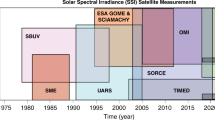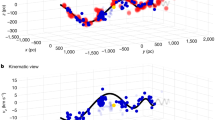Abstract
The 0.1–0.3% dips in solar irradiance during disk passages of large sunspot groups suggest the possibility of fluctuations in the solar luminosity. This raises the question of whether the energy not radiated by the dark sunspots is stored within the Sun for long periods of time, or is radiated by faculae during the several-month lifetime of a solar activity complex1–3. Here we examine the sunspot and facular contributions to luminosity fluctuations due to a solar activity complex over its lifetime from June to November 1982. Both direct, photometric observations of irradiance fluctuations and modelled ‘proxy’ fluctuations based on published sunspot and calcium plage areas are used. We find that the total facular energy excess is between 70 and 120% of the sunspot deficit of ∼1037 erg. Thus, at a minimum, a major portion of the missing sunspot flux is radiated by faculae, and energy balance or even an excess is possible. This work differs from earlier studies2–9 in that our data cover a longer period of time, more photometric data are included, and our analysis considers the effect of partial occultation of active regions by the solar limb.
This is a preview of subscription content, access via your institution
Access options
Subscribe to this journal
Receive 51 print issues and online access
$199.00 per year
only $3.90 per issue
Buy this article
- Purchase on Springer Link
- Instant access to full article PDF
Prices may be subject to local taxes which are calculated during checkout
Similar content being viewed by others
References
Willson, R. C. et al. Science 211, 700–702 (1981).
Eddy, J. A., Gilliland, R. L. & Hoyt, D. V. Nature 300, 689–693 (1982).
Oster, L., Schatten, K. H. & Sofia, S. Astrophys. J. 256, 768–773 (1982).
Lawrence, J.K., Chapman, G.A., Herzog, A.D. & Shelton, J.C. Astrophys. J. 292, 297 (1985).
Chapman, G. A., Herzog, A. D., Lawrence, J. K. & Shelton, J. C. Astrophys. J. Lett. 282, L99 (1984).
Chapman, G. A. Nature 308, 252–254 (1984).
Willson, R. C. & Hudson, H. S. Astrophys. J. Lett. 254, L185 (1981).
Chapman, G. A. & Groisman, G. Sol. Phys. 91, 45–50 (1984).
Schatten, K. H. et al. Astrophys. J. 294, 689–696 (1985).
Chapman, G. A. & Meyer, A. D. Sol. Phys. (in the press).
Lean, J. L. J. geophys. Res. 89, 1–9 (1984).
Samain, D. Astr. Astrophys. 74, 225–228 (1979).
Bray, R. J. & Loughhead, R. E. Sunspots, 226 (Chapman and Hall, London, 1964).
Author information
Authors and Affiliations
Rights and permissions
About this article
Cite this article
Chapman, G., Herzog, A. & Lawrence, J. Time-integrated energy budget of a solar activity complex. Nature 319, 654–655 (1986). https://doi.org/10.1038/319654a0
Received:
Accepted:
Issue Date:
DOI: https://doi.org/10.1038/319654a0
This article is cited by
-
Solar radiant flux: Modern data and related problems
Radiophysics and Quantum Electronics (1996)
-
Calcium plage intensity and solar irradiance variations
Solar Physics (1991)
-
Facular structures derived from precise two-color contrast observations
Solar Physics (1990)
-
Time profiles of solar irradiance dips
Solar Physics (1990)
-
Variation of the solar constant connected with the coronal activity
Solar Physics (1987)
Comments
By submitting a comment you agree to abide by our Terms and Community Guidelines. If you find something abusive or that does not comply with our terms or guidelines please flag it as inappropriate.



